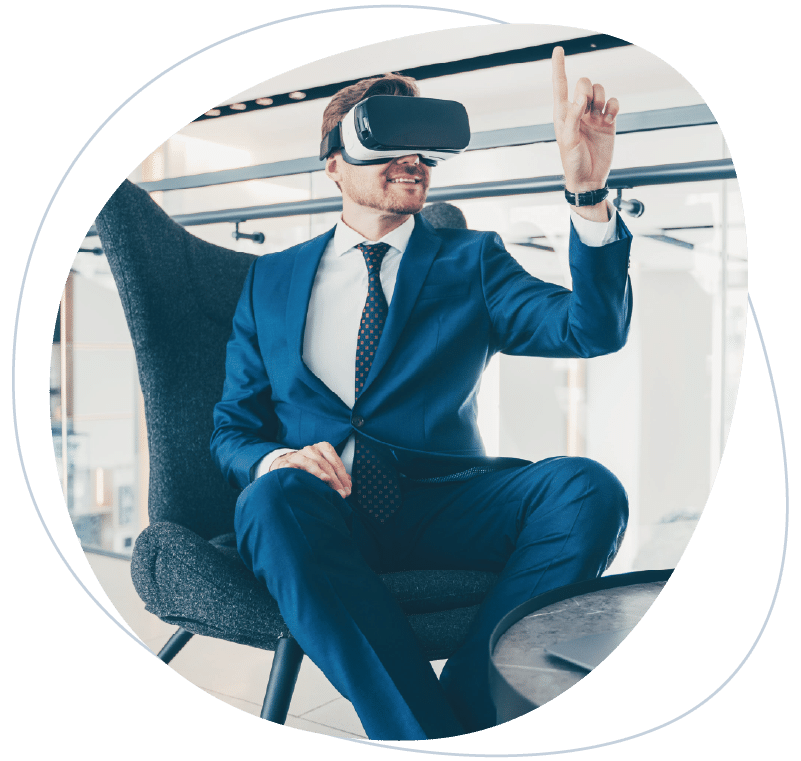Guide
L&D Leaders’ Survive & Thrive Guide 2025:
Key Trends and Critical Actions

2025: L&D must strengthen its strategic influence
Key Trends:
Trend 1: Skills agility becomes a business superpower
Trend 2: Organization-led training steps into the spotlight
Trend 3: Training happens anywhere, anytime
Trend 4: AI adoption becomes more discerning
Trend 5: Best-in-class rises to the top
Trend 6: L&D solutions become more flexible and comprehensive
Trend 7: Gen Z and Gen Alpha demand faster career growth
Trend 8: Compliance training goes next-level
Learning and development leaders are at a crossroads. RedThread Research recently found that there’s been a 50% drop in L&D’s involvement in business strategy discussions over the past two years. This alarming retreat risks L&D becoming shut out when needed most to help businesses adapt in a fast-moving and ever-evolving business landscape.
As we approach 2025, L&D leaders can strengthen their roles as strategic advisors by balancing innovation with practicality—embracing the strategies and tools that close immediate training gaps, while advancing critical skills-based initiatives.
This guide explores the nine trends that will help L&D reclaim its seat at the table in 2025. From integrating AI-powered personalization to creating flexible, engaging learning environments, each trend offers a roadmap for leaders to maximize their strategic impact.
Whether it’s embracing immersive technologies like VR, transitioning to best-in-class learning ecosystems, or addressing generational shifts in career expectations, our goal is to provide you with practical guidance on how L&D can continually evolve to empower employees and help shape the future of the business.
Trend 1: Skills agility becomes a business superpower
PwC reports that CEOs today expect more pressure to perform over the next three years due to technology, tariffs, and nearly every other megatrend affecting global business. Because of this, it’s critical that the organization be equipped with the skills to both address immediate skills gaps and prepare for what’s to come.
In 2025, L&D leaders must make skills development one of their strategic imperatives. This means designing training that prepares employees for future shifts and being more prescriptive with the courses offered to learners. Focusing on skill agility will enhance adaptability, build resilience, and drive retention, ensuring employees see their careers grow and remain valuable to the organization as roles and technologies evolve.
Capitalize on this trend by:
Using your LMS to match skills: ExpertusONE leverages AI to quickly parse through a library of over 25,000 industry-spanning skills and connect skills directly to learners, jobs, and training modules.
Validating skills competency: Ensure that everyone’s working towards your organization’s goals with automatically generated skills assessments for leaders and assessors.

Trend 2: Organization-led training steps into the spotlight
The quest to upskill and reskill employees isn’t new; yet only 18% of companies have a unified skills strategy across their organization. In 2025, L&D leaders have a huge opportunity to develop a strong skills strategy for the future that is organization-led rather than employee-driven.
Leaving skills development to self-selection doesn’t always lead to employees choosing the skills that are critical to futureproofing the business. What’s needed are more organization-led upskilling programs, where L&D is proactively placing the right employees in the right skills training to keep everyone on track.
By defining the organization’s future skills needs and assigning training to employees who fit the skills profile for these, L&D leaders can ensure employees acquire the critical skills to strengthen overall organizational agility and competitive advantage.
Capitalize on this trend by:
Upskilling by learner group: Guide your organization’s upskilling journey by creating skill-driven learner groups based on any combination of defining factors, such as skills gaps, tenure, job, and manager level, or upload a list of learners best suited for upskilling.
Leveraging career pathing: ExpertusONE’s career pathing builds on your existing job hierarchy and an employee’s career progression to illustrate the potential paths forward and the skills gaps they need to close.
To truly upskill an organization and adapt to the rapidly changing pace of work, skills-based learning doesn’t need to just be available, it needs to target the right people and hold them accountable for completing it.
See how Elliott Group, a global manufacturer, used ExpertusONE to upskill managers with a flexible and engaging skills-based program.
Trend 3: Training happens anywhere, anytime
While office returns were a big trend in 2024, there will still be a critical need for flexible, accessible training in the coming year. In 2025, everyone in the learning enterprise—whether it’s employees, instructors, or managers—will expect training that fits into their unique work environments, whether that’s at home, in the office, or the field around the globe.
In 2025, leading organizations will provide multi-device, mobile-friendly, and self-paced learning solutions. Learners can access their training resources whenever and wherever they need them. Even better, the LMS will ensure that users can move from their computer to mobile device and pick up right where they left off in the course for a seamless experience.
Flexible platforms like ExpertusONE also empower learners to leverage one-click class registration and launch on any device, providing a frustration-free learner experience. From one screen, learners can stay on top of all their training activities, manage their courses and training orders, and check their plan progress.
Capitalize on this trend by:
Embedding training and learning in everyday workflows: With ExpertusONE, you can easily publish training, run virtual classes, and share training resources from Salesforce, MS Teams, or Slack.
Improving trainer productivity: Instructors should be able to access actionable analytics, push surveys and assessments, make scheduling changes, and complete observational assessments—all from their mobile devices.
“We selected the ExpertusONE LMS because it put training right at our learners’ fingertips. [We’ve] had excellent feedback on how streamlined and easy [it] is to use”
— Director of Operations, Education & Product Adoption at Global Leader of Cloud Services
Trend 4: AI adoption becomes more discerning
According to PwC’s 27th Annual Global CEO Survey, within the next three years, seven in ten CEOs anticipate Generative AI will increase competition, drive changes to their business models, and require new skills from their workforce.
Even L&D has benefited from the transformative effects of AI. From talent acquisition to onboarding, training, and career progression, AI will play a pivotal role in optimizing every aspect of employee development. However, 2025 will be the year that HR teams will also be asking deeper questions about AI’s applications in L&D, assessing it for ethical standards, bias prevention, and effectiveness.
L&D leaders should prepare for scrutiny around their use of AI and ensure its use aligns with organizational values. The emphasis will be on transparency and the responsible use of AI to enhance learning rather than replace human judgment. Although AI enhances learning efficiency, the value of human interaction, guidance, and mentorship can not be replaced by technology. Organizations must find the right blend of AI-driven automation and human involvement to create a holistic and effective learning environment.
Capitalize on this trend by:
Conducting an audit of your AI tools: A transparent audit will prepare L&D teams to answer any questions about the platform’s fairness, effectiveness, and alignment with organizational values.
Aligning AI with strategic use cases: L&D leaders should prove the technology’s relevance by proactively identifying the priority areas where AI can deliver measurable value. Examples include personalized learning pathways, skill gap analysis, or predictive analytics.

Trend 5: Best-in-class rises to the top
As organizations see diminishing returns from rigid all-in-one HR suites, 2025 will mark a shift to ecosystems that provide best-in-class solutions. L&D leaders will prioritize “best for you” learning management systems (LMS) over “best for all” platforms, with the goal of creating more effective learning environments that support diverse learning needs.
A purpose-built LMS serves as the central hub for learning initiatives, offering a seamless platform to deliver and manage various training programs, while easily integrating with other critical employee systems like performance management and employee engagement.
This centralized approach ensures consistency in content delivery, branding, and messaging, aligning with the organization’s overarching goals. It also means getting the deep functionality, personalization, and integrations needed to enhance the experience of every learner and meet the unique and complex needs of the organization.
But it’s not only learners that benefit from a purpose-built LMS. Admins are the backbone of the LMS, responsible for a range of tasks including user management, content updates, reporting, and technical troubleshooting. When the platform is developed to help admins complete their tasks efficiently and without frustration, it delivers even more value.
Capitalize on this trend by:
Assessing the top LMS features you need: To determine if your current LMS is enough, sit with your team and identify the essential functions the platform must perform. To help, we’ve narrowed down these functions to the most important, which you can read about in our Top 10 Enterprise LMS Features: The No-Fluff Guide.
Asking LMS vendors the right questions: Once you know what features you want, have pointed discussions with vendors to learn if they can deliver on your organization’s needs. Here are some questions to start you off.
“Early on, it became obvious that our existing learning management system software was inadequate to sustain and expand our new competency training program. [We] chose the ExpertusONE LMS primarily because of its intuitive usability for employees, managers, distributors, and customers.”
— Manager, Education Services at the World’s Largest Technology Provider
Trend 6: L&D solutions become more flexible and comprehensive
As talent development strategies continue to evolve, the role of the LMS becomes increasingly vital. In 2025, companies will push SaaS providers in the L&D space to offer more modular, customizable options that reflect the unique needs of their business.
This flexibility extends to the overall learning experience: configurable dashboards, role-specific interfaces, and integration with existing tools can significantly enhance the learner experience. Whether you’re onboarding new hires, upskilling existing employees, or delivering training to the extended enterprise, your LMS must offer a scalable and cost-effective solution for meeting diverse talent development requirements.
For example, offering tools that allow a large partner to manage their sales training as part of a larger enablement strategy—choosing who to register, the courses to enroll them in, and when they should start training—while a smaller organization can opt to let your team manage the program entirely.
Capitalize on this trend by:
Go deeper in evaluating the LMS platform and provider capabilities: Your LMS vendor should offer the best of both SaaS technology and tailored solutions that fit your unique business requirements. You should be able to work with them to maximize impact and relevance for each learner in your organization.
Gaining the ability to train and serve multiple audiences simultaneously: Your LMS should enable you to easily provide unique interfaces and training programs for as many learning groups as you’d like, whether it’s multiple subsidiaries under a parent company, training partners, customers, and employees, or supporting regional needs.
Trend 7: Gen Z and Gen Alpha demand faster career growth
By 2025, Gen Z will make up 27% of the global workforce, while many Gen Alpha will be making their way into their first after-school jobs. These generations will value rapid skill development and clear career trajectories more than any other cohort before them. In 2025, L&D leaders must be prepared to adapt training, and even create new programs, to the unique learning needs of this segment.

Advancing in their careers will be imperative to Gen Z and Gen Alpha’s satisfaction and happiness at work. L&D will play a crucial role in facilitating this by designing targeted programs that enable quick progression, ensuring these early career professionals acquire the necessary skills to advance.
Instructors and managers must also be given the right training to support these employees, such as how to take a genuine, human-centered approach to career development conversations and the steps to take to follow through on promises of advancement, whether within or beyond the organization.
Capitalize on this trend by:
Making it easy to build learning playlists: Empower Gen Z and Gen Alpha to take control of their learning with the ability to curate and arrange the courses they want into a collection that best fits their learning journey.
Offering micro-content: This age group is video-native and responds better to learning that is interactive rather than passive–Marry these two concepts with ExpertusONE’s Interaction Studio where you can add questions and activities to existing videos. Think short-form videos, quick soundbites in presentations, gamification, and more.
Trend 8: Compliance training goes next-level
Training that checks the box is no longer enough, especially when individuals and companies face serious consequences when things go wrong. In 2025, L&D leaders will face increased pressure to make compliance and behavioral training more effective, ensuring it genuinely impacts behavior.
With accountability for regulatory training at an all-time high, companies need to invest to make training engaging, using interactive presentations, videos, gamification, social learning, and more. This approach makes training more engaging and memorable so employees don’t check out in the middle of the course.
This trend also extends to the management side of compliance training, which can often be a tedious process that spurs many overworked admins to keep it to a one-off program or once-a-year event. However, by leveraging an always-on learning platform that integrates compliance training into your everyday workflows, risk management becomes an ongoing practice free from headaches.
Capitalize on this trend by:
Giving managers more clarity and insight: Managers should have access to a team view that provides a consolidated list of employees to view training progress, check activity, and assign learning so they can easily keep on top of their team’s compliance.
Automating training notifications: With ExpertusONE you can automate deadline reminders, follow-up emails, and notifications for individual team members to keep them on schedule for training completion.
“Not only could we use the ExpertusONE LMS to automate our internal compliance reporting and management, but we could also extend its compliance functionality to our clients… which is a huge value to them and a great sale for us”
— Sr. Director of Education Services at Mortgage Technology Company
Trend 9: Virtual reality becomes a training reality
For years, virtual reality (VR) has been a tantalizing prospect in learning and development, promising immersive and impactful training experiences. A study by PwC found that VR learners were 4x faster to train than in a classroom setting and 275% more confident to apply the skills they learned. In 2025, VR will become a more widespread reality as advances in technology make the hardware more affordable, portable, and accessible than ever before.

VR’s potential in fields like technical training, customer service, and leadership development offers high engagement and retention. However, L&D leaders should assess how VR can enhance training, particularly for scenarios where traditional methods fall short, such as high-stakes simulations or experiential learning.
Imagine equipping customer service teams with VR simulations that mimic challenging interactions with clients, allowing them to build empathy and refine their problem-solving skills. Or envision leaders-in-training navigating decision-making scenarios under pressure, gaining experience in a safe yet engaging setting. These immersive experiences enhance engagement and improve knowledge retention, addressing the gaps that traditional classroom or e-learning methods often can’t fill.
Capitalize on this trend by:
Experimenting with a VR pilot: Aim for a phased approach when introducing a new technology like VR, such as with a small pilot course to test and ease everyone into using it.
Building a blended learning curriculum: Once you’ve onboarded VR training into your organization, use an LMS like ExpertusONE to make it easily discoverable through personalized learning paths and engaging interactive modules.
Your 2025 Action Plan
From leveraging AI for personalized learning experiences to adopting immersive technologies like virtual reality, L&D leaders must be ready to innovate and adapt in 2025. Becoming a strategic advisor to the business means keeping pace with the evolving expectations of learners and the changing market landscape.
Success in 2025 will require more than just adopting new technologies or methodologies—it will demand a strategic, learner-centric mindset that prioritizes continuous improvement, alignment with organizational goals, and measurable outcomes. By implementing these nine key trends, organizations can build a more resilient, agile, and future-ready learning culture.


